The US Automotive Stamped Component Market is characterized by a dynamic landscape where numerous players are vying for market share through innovation and strategic positioning. This market plays a crucial role in the automotive industry, supplying a range of stamped components that are integral to vehicle manufacturing and assembly. With the increasing demand for lightweight and durable automotive parts, companies are focusing on advanced manufacturing processes, automation, and material science to enhance their product offerings.
Competitive strategies often revolve around pricing, product quality, and the ability to swiftly adapt to emerging trends. As the automotive industry embraces electrification and smart technologies, companies within this segment are also exploring sustainable manufacturing practices and new materials to meet regulatory standards and consumer preferences.DANA Incorporated stands out in the US Automotive Stamped Component Market due to its robust portfolio and specialization in driveline and sealing technologies. The company has built a strong reputation for delivering high-quality stamped components that meet the rigorous demands of modern vehicles.
DANA Incorporated leverages advanced engineering capabilities and extensive experience to create innovative solutions tailored to the needs of both original equipment manufacturers and aftermarket customers.
Its commitment to research and development enables the company to stay ahead of industry trends and maintain a competitive edge. The company’s presence in the US market is reinforced by its established relationships with key automotive players, ensuring a stable demand for its products driven by technical excellence and customer-centric approaches.Tenneco also holds a significant position in the US Automotive Stamped Component Market, primarily focusing on the design and manufacture of clean air and ride performance products.
The company's extensive product range includes exhaust and emission control components, which play a vital role in meeting environmental regulations and enhancing vehicle performance.
Tenneco’s strengths lie in its comprehensive engineering expertise and ability to provide integrated solutions that address the complexity of modern automotive requirements. Over recent years, Tenneco has pursued strategic mergers and acquisitions to strengthen its market presence and expand its capabilities, allowing it to better serve a diverse customer base. Its commitment to innovation and sustainability positions Tenneco as a strong competitor, emphasizing the advancement of cleaner technologies in the automotive sector as it navigates shifts toward electrification and heightened emissions standards within the US market.




















